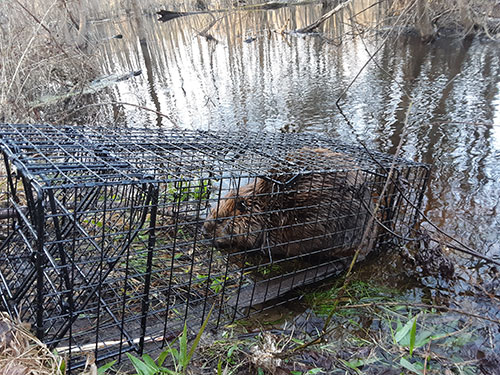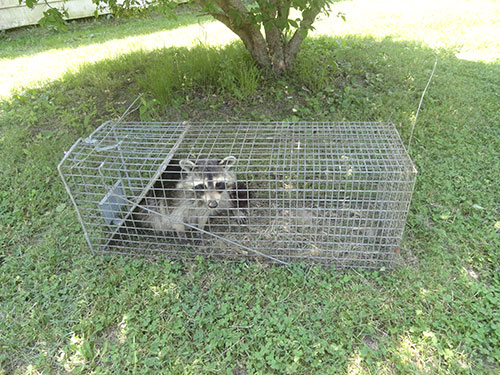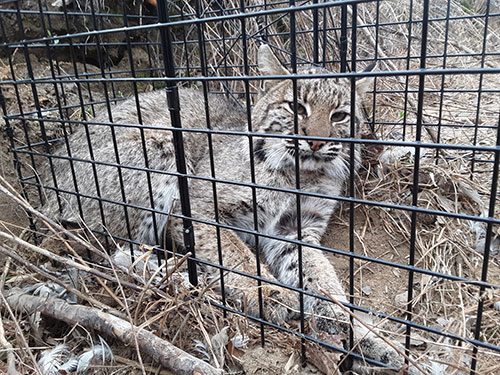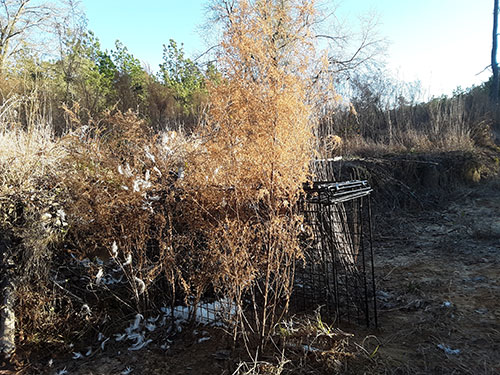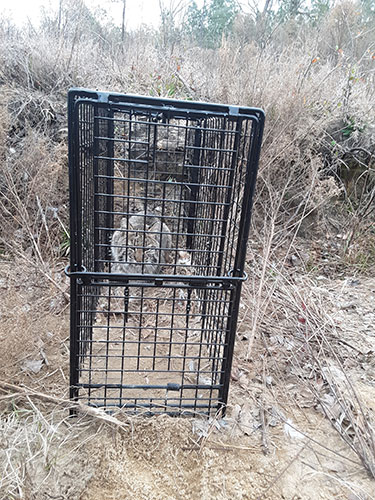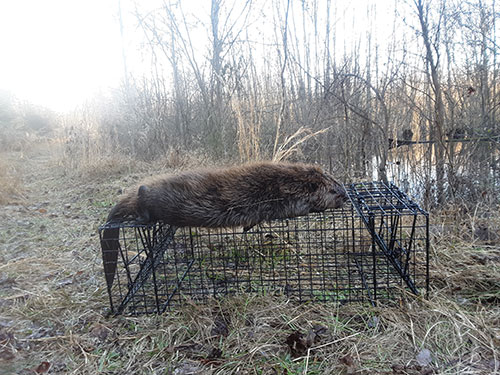The author discusses the ins and outs of using cage traps for a variety of furbearers.
By Jason Houser
When it comes to trapping just about any furbearer, there are more than enough types of traps and manufacturers to go around. Traps come in every size you can think of, whether you are trying to decide on footholds, bodygrips, dog-proof traps and even cage traps. The task can get confusing, especially for newcomers to the sport.
Still, with a variety of traps to choose from, the selection process does get easier with cage traps. Yes, they do come in a lot of sizes and even different styles, but it’s a lot easier to distinguish the right trap for a particular animal.
You wouldn’t want to purchase a beaver cage trap to catch a raccoon and vice versa. That is what helps with the selection process. Most cage traps will tell you right in the name of the trap what they are intended for. Take, for example, Tomahawk Live Trap’s website. You can search for traps by animal and find exactly what you are looking for. This takes the guessing out of what size of trap is going to do the best job.
Cage traps come in many styles and sizes. Some cage traps have two doors that allow an animal to enter from either end, with wire triggers that the animal must push for the doors to close. Others have guillotine-style doors that will allow the trap to be placed right against a building, which is great for situations such as a trail coming out from underneath a porch or barn. While others have the conventional door that protrudes a few inches in front of the trap’s entrance, with a pan on the bottom of the trap that the animal must push down for the door to release.
Cage traps all work on the same basic principle. Like other traps, it is placed in known areas where there are specific animals you are targeting. A bait and or lure is placed inside the trap. These attractants are usually placed right behind the trap pan on a single-door trap and underneath the wires on a double-door trap.
As trappers, we at times catch incidental animals. Maybe we catch an animal that is a little small or not in season, and they need to be released. A cage trap makes releasing animals easy. Simply lift the door and let the animal go. Safety protocols still need to be followed. Be aware of where the animal goes, keep your hands clear of the animal’s mouth and feet, and if needed wear leather gloves to help protect yourself.
Raccoons
I do not have statistics to prove this, but I would wager that raccoons are the number one animal caught in cage traps. Animal damage control trappers and even fur trappers are using these traps to catch a lot of raccoons every year. For good reasons, they are outstanding at catching ‘coons.
Even in a cage trap, a raccoon will attempt to tear everything up. It’s not uncommon once you catch a ‘coon that you will find the trap has been moved and the ground is torn up under the trap where the ‘coon was fighting to get out. For this reason, you want a sturdy raccoon trap that can handle the abuse. Tomahawk Live Trap sells many styles of strong cage traps that can handle the largest ‘coons.
If you are in an area where there are raccoons, it is not difficult to entice them into a trap. My favorite baits for this are marshmallows and dry cat food. I begin with a trail of bait leading into the trap and beyond the trigger, whether it is a pan or wire. I also take a cotton swab and dip it into a commercial food bait and stick it near the trigger. I also add a trailing scent of fish oil to finish the set.
Bobcats
Another common furbearer that cage traps are great for are bobcats. A cage trap is a top choice for bobcats where there is a limit on cats, such as my home state of Illinois, where lucky permit winners can only keep one per year. It’s much easier to release a live bobcat from a cage trap than a foothold, and there is no releasing one from a bodygrip trap.
I have trapped with cage traps in many states for bobcats and they work extremely well. Again, you have to set on location. These are just about as easy to set as you would for ‘coons.
I do not use a trailing scent for bobcats. All I do is place bait in the trap, whether it is a commercial bait, or your own meat bait where legal. They both work well. Also, I like to add a small amount of lure for the added smell.
Bobcats often rely on visual attractions — even more than smell. For that reason, it’s always a good idea to give them something to look at. A CD suspended in the back of the trap works perfectly. Something that I learned from friends in South Carolina is to use feathers from a down pillow. Goose or duck feathers both work well. This is a lot easier than having to gather feathers from their source.
When using feathers, don’t be shy. Make it look like a bird died there. Toss them in the back of the trap, in front of and around the sides. Give it a good visual attraction that a bobcat won’t pass up. The last thing I like to do is blend in the sides of the trap with some twigs and grasses so it doesn’t look like a box to them.
Beavers
Many people do not understand how effective a cage trap can be for beavers, or how to make sets for beavers using cage traps. Don’t be surprised if you catch otters while trapping for beavers with cage traps.
Probably the biggest reason trappers choose cage traps for beavers is their ease of setting. Cage traps might be a tad bigger than what many trappers are accustomed to carrying on the line, but their size should not keep you from trying one or two. If you can drive right up to the set location, these traps are absolutely what you are looking for.
To catch a lot of beavers in a hurry use multiple traps in one channel. But, there are not many beaver-size cage traps on the market. After trying out a few, I have settled on Jim Comstock’s double-door beaver trap. This trap is strong and measures in at 39x18x12 inches, so it is large enough to hold the largest beavers you are going to catch.
In a shallow, wide creek I would have enough cage traps to set side by side the entire width of the stream with a log placed over the top of them to close off the whole creek. It might take three or four traps, but I could catch three or four beavers in one night. In deep water in the neighborhood of 25 to 30 inches, that is narrow enough that one trap will cover the width, I have stacked traps one on top of another with both traps producing beaver catches. It might be necessary to push stakes through the traps to hold them in place, especially if the water is moving fast.
The only option that a beaver has if an entire creek is covered in cage traps is to go through the trap.
As far as lures go, they aren’t necessary if the entire creek is fenced off with traps. The beaver is going to be swimming through, whether or not the lure or bait is provoking them to come. It is as simple as putting the traps in the water and moving on.
One of the main reasons I am using more and more cage traps for beavers is because of their versatility. No rules are governing how to set them in my areas. They can be set in shallow water, deep water, on land and even upside down, which I recommend when using a Comstock beaver trap. The powerful doors will lift and push the animal into the trap.
In a wide creek covering several feet, it would not make sense to fence it off for one conibear or snare. It would take too much time and the sets would have to be made in a manner where the traps would stay in place once a beaver was caught. The chances are just too high that a beaver would pull up the trap and spring the other traps if you did fence the area off and set multiple traps.
Some of the best locations for cage traps are culverts, on ledges and cobblestones. However, I have successfully caught beavers in cage traps using a castor mound set. I made an artificial castor mound, lured it with castor, and set the cage trap in the water right next to the bank. I have had beavers ignore castor sets guarded with bodygrips and swim into my cage traps to get to the mounds. They are not scared to enter a cage trap.
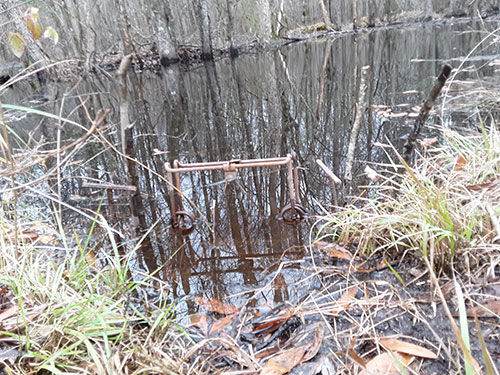
It will be tough for some trappers to move away from traps they are used to using, and making the switch to cage traps. Photo credit Jason Houser.
Cage traps might not be for everyone, but I’m seeing more and more trappers use them. There is a cage trap for just about everything from chipmunks to coyotes. They are easy to set and bait, and they help trappers be selective with what they keep. In today’s crazy fur market, it doesn’t hurt to be able to keep only the best fur, and release the rest.
